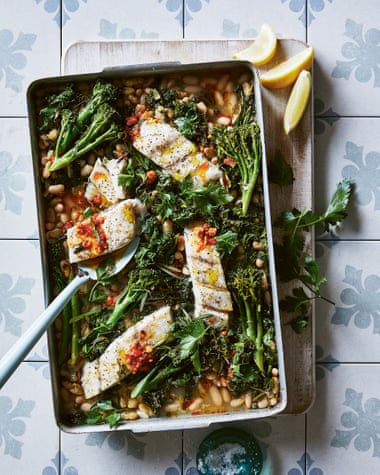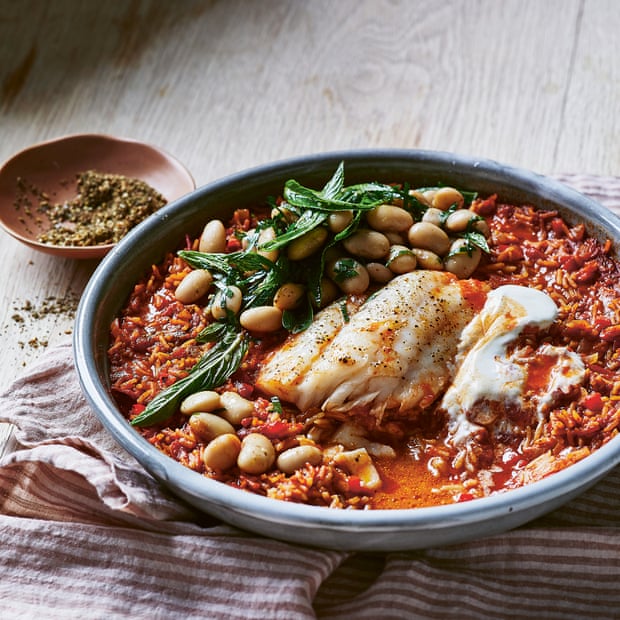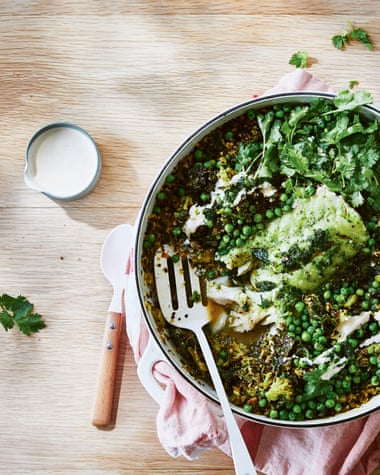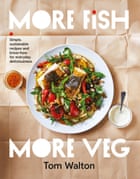
There is something truly magical about one-pot cooking – it screams comfort and nourishment, and you always feel like you’re winning when producing flavour so effortlessly.
One-tray roast fish with brothy white beans, capers and lemon
This is delicious, no-fuss cooking, perfect for a quick lunch or dinner. If you don’t have a sauté pan that can go in the oven, just spoon the brothy beans into a baking dish, then top them with the fish.
Serves 4
80ml olive oil, plus extra to drizzle
½ small leek, chopped
4 cloves garlic, sliced
2 sprigs rosemary
4 anchovy fillets (optional)
45g capers, rinsed and drained
Sea salt flakes and ground black pepper
1 lemon, juiced and finely zested, plus 1 lemon extra, cut into wedges
¼ bunch kale leaves, thinly sliced
1 bunch broccolini, cut into shorter lengths
500ml vegetable stock
2 x 400g cans cannellini beans, rinsed and drained
Handful flat-leaf parsley leaves, roughly chopped
600g blue-eye trevalla or other firm white-fleshed fish fillet, skin removed
115g salmoriglio (see below)
Preheat the oven to 200C.
Place a large ovenproof sauté pan over medium–high heat. Add 60ml of the olive oil and the leek, garlic, rosemary, anchovies (if using), capers and a pinch of salt. Cook, stirring, for three minutes to soften the leek and break down the anchovies, then add the lemon zest, kale and broccolini and cook until the kale is slightly wilted, around one minute. Add the stock and cannellini beans and bring to the boil, then stir through the parsley and lemon juice. Season to taste with a little salt and pepper.
Place the fish in a shallow bowl, season with salt and pepper and drizzle with the remaining olive oil to coat it. Nestle the fish in the brothy beans and place the whole pan in the oven for six minutes, until the fish is just cooked.
Spoon the salmoriglio over the fish and serve with the lemon wedges and a drizzle of olive oil.
Salmoriglio
This herby sauce (otherwise known as your best friend) is the flavour of Italy’s south. Use it as a dressing, marinade or spooned over fish. Traditionally, it’s teamed with swordfish, but any fish, seafood or roast veggies would work wonderfully. I also stir it through yoghurt, spoon it into soups, or use it to marinate fish in before roasting or chargrilling, finishing with some more sauce after cooking. It also makes a knockout pasta sauce.
Makes 330ml
2 cloves garlic, finely crushed
1 bunch oregano, leaves picked
Large handful flat-leaf parsley leaves
Juice of 2 lemons
200ml extra-virgin olive oil
Sea salt flakes and ground black pepper
Place all the ingredients in a blender or food processor and blend into a rustic sauce that’s not too emulsified – you want it loose.
Alternatively, use a mortar and pestle to pound the garlic and herbs into a paste, then mix through the lemon juice and oil and season to taste.
Transfer to an airtight container or jar and store in the fridge for up to one week.
Smoky butter beans with fish and rice
This recipe uses a poaching technique, which is one of the gentlest ways to cook fish. It’s perfect if you’re just starting out, and is great for small kitchens, as you don’t need much room and there are less smells sticking around afterwards. Just remember to season your sauce before adding the fish.

Serves 4
60ml olive oil
1 small brown onion, finely chopped
1 small red capsicum, finely chopped
2 cloves garlic, sliced
Sea salt flakes and ground black pepper
1–2 tbsp homemade chilli salsa, or use store-bought chipotle in adobo
2 tsp sweet smoked paprika
1 tbsp ground cumin
200g basmati or long-grain rice
1 x 400g can crushed tomatoes
800ml vegetable or chicken stock
500g skinless boneless ling fillet, or any other firm white-fleshed fish, such as blue-eye trevalla, hake or snapper
1 x 400g can butter beans, rinsed and drained
Handful flat-leaf parsley leaves, roughly chopped
Handful mint leaves, roughly chopped, plus extra whole leaves to serve
2 tbsp extra-virgin olive oil
Juice of 1 lemon
1 tbsp za’atar (optional)
130g natural Greek-style yoghurt
Place a large shallow casserole dish or frying pan over medium–high heat and add the olive oil, onion, capsicum, garlic and a good pinch of salt and pepper. Cook, stirring often, for four minutes, until the vegetables are soft, then add the chilli salsa or chipotle, the paprika and cumin and stir through. Cook for one more minute, then add the rice, crushed tomatoes and stock, and bring to the boil.
Reduce the heat to a simmer and cook the vegetables and rice for six minutes, stirring often, until the rice is partially cooked.
Lightly season the fish with salt and pepper, then nestle it in the vegetables and rice. Give the pan a gentle shake to allow the fish to settle in. Spoon some sauce over the fish, then cover the pan with a lid and cook for around six minutes. Remove the pan from the heat and allow the fish to rest for five minutes.
Meanwhile, place the butter beans in a bowl with the herbs. Dress with the extra-virgin olive oil, lemon juice and a little salt and pepper, and mix to combine.
Spoon the butter beans and dressing around the fish. Sprinkle with the za’atar (if using), and serve with the yoghurt and extra mint leaves.
Green shakshuka, quinoa and fish
This is a great take on classic shakshuka for those who can’t eat tomatoes, or want to try a different version. I love to make this recipe up to an hour ahead of time and then gently reheat it on the stovetop before serving. Leftovers are also great the next day.
If you don’t have quinoa, use basmati rice or freekeh. Choose any mix of greens you like or have on hand. If you are catering for multiple dietary needs, bake the fish on a separate tray and keep the shakshuka plant-based.
Serves 4
80ml olive oil
½ small leek, or 1 small brown onion, finely chopped
2 cloves garlic, sliced
Sea salt flakes and ground black pepper
1½ tbsp ras el hanout, available at well-stocked supermarkets and some grocers
1 small head broccoli, thinly chopped, stalk and all
½ bunch kale or cavolo nero, leaves thinly sliced, stalks discarded
2 zucchinis, grated
200g mixed-colour quinoa, rinsed
625ml vegetable stock
600g firm white-fleshed fish fillet, such as blue-eye trevalla, gemfish or ling
80ml store-bought dairy-free pesto
140g frozen peas
Handful coriander leaves, roughly chopped
140g natural Greek-style yoghurt or garlicky whipped tahini (see below)
2 lemons, cut into wedges

Place a large shallow casserole dish or frying pan over medium–high heat. Add two tablespoons of the olive oil, the leek or onion, garlic and a pinch of salt. Cook, stirring, for around three minutes until the leek is soft, then add the ras el hanout and broccoli and continue cooking for one minute. Add the kale, zucchini and a crack of pepper and cook for two minutes, until the kale begins to wilt.
Add the quinoa to the dish or pan and stir through, then pour in the vegetable stock and stir everything until evenly distributed. Adjust the seasoning and bring to the boil. Cover, reduce the heat to a simmer and cook for 10 minutes.
Season the fish with salt and pepper and gently combine with the remaining olive oil and half the dairy-free pesto. Nestle the fish into the veggies and quinoa, scatter the frozen peas over the top and cover with a lid.
Continue to cook over low heat for a further 10 minutes, keeping an eye on the fish as it cooks; you don’t want to overcook it.
Remove the dish or pan from the heat and allow it to stand for five minutes. Drizzle with the remaining pesto, scatter the coriander over the top and serve with the garlicky whipped tahini or yoghurt and lemon wedges.
Garlicky whipped tahini
This is my everything sauce. It also makes a killer dip and is a great vegan replacement for yoghurt. I love this sauce as it is, but you could add so many other flavours to it including chilli, spices or miso.
If your sauce is too runny, just add some more tahini. If you make this by hand, your tahini might look like it has split or it may clump together, but that just means it needs more water and whisking. For a lighter version, make this in a blender.

Makes 350g
135g hulled tahini
Juice of 1 lemon
2 cloves garlic, finely crushed
Sea salt flakes and ground black pepper
Place all the ingredients in a blender with 170ml of water and blend into a smooth paste. Adjust the water and lemon juice until you have a silky consistency.
Alternatively, combine the ingredients in a bowl with a whisk or fork, whisking in the water slowly until smooth and combined. Transfer to an airtight container or jar and store in the fridge for up to one week.
-
This is an edited extract from More Fish, More Veg by Tom Walton, published by Murdoch Books (RRP39.99). Photography by Rob Palmer



